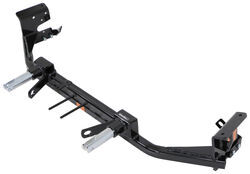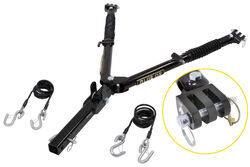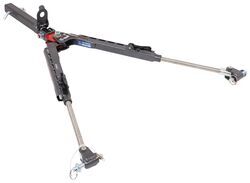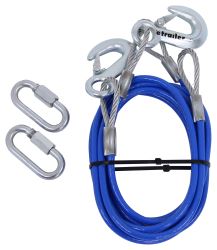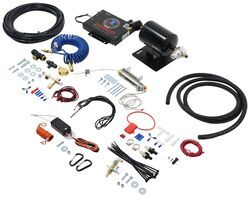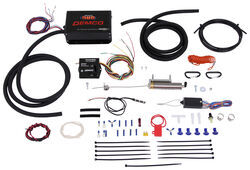
Flat Tow Parts For 2019 GMC Acadia
Question:
What is the recommended parts to tow my Acadia behind my motor home. What about the Ascent tow bar?
asked by: Rick R
Expert Reply:
I looked up the owners manual for you 2019 GMC Acadia and it says that both FWD and AWD models with the 3.6L V6 can be towed with all 4 wheels on the ground. If you have the 2.4L L4 it states that it is not designed to be towed with all 4 wheels on the ground. I recommend that you verify what the owners manual states and verify how your Acadia is equipped. The manual will also outline the procedure of how to put your Acadia into tow mode before your trip.
To flat tow your Acadia there are 5 main components you'll need. A base plate, a tow bar, tow bar wiring, safety cables and a supplemental braking system.
The Blue Ox Ascent Tow Bar # BX4370 you referenced will work for your Acadia and a base plate that is also confirmed to fit your Acadia is the Blue Ox base plate with removable arms # BX1728. Typically it's easiest to get a tow bar and base plate from the same manufacturer so there is no need for adapters.
I have always like Roadmaster's tow bars, so I'll list my recommendations below. If you are set on the Blue Ox Ascent, I recommend getting the Blue Ox base plate, but all the other parts will still be compatible.
The base plate is the attachment point on your Acadia for the tow bar to hook up to. Assuming that you have the 3.6L V6, I recommend the Roadmaster Direct-Connect Base Plate Kit # RM-523189-5. I have always like Roadmaster base plates, they seem to install easier than most, and they have removable arms so when your not towing your Acadia it will have a clean look. The base plate determines which tow bar you can use without the need of an adapter.
The tow bar is what actually connects your motor home to the Acadia. I recommend Roadmaster Falcon All Terrain, Non-Binding Tow Bar # RM-522. It's compatible with the base plate I recommended and I really like this tow bar. It's non binding so it's much easier to unhook compared to binding tow bars. The old binding style tow bars can be a hassle to unhook because of the pressure that's put of the attachment pins. But the Falcon all terrain has built in levers to take the pressure off and make unhooking a breeze.
Tow bar wiring is what sends the light signals from your motor home to the Acadia so that when you are driving everyone can know your intentions; driving at night with your tail lights on, or changing lanes. Just like when towing a trailer you need lights at the back. I recommend Roadmaster 4-Diode Universal Wiring Kit for Towed Vehicles # RM-152-98146-7. The kit includes all the wiring and connectors to get it installed, and even the umbilical cable to connect the back of the motor home to the front of your Acadia.
Safety cables are a secondary safety device that are required whenever towing and the RoadMaster 76" Single Hook, Straight Safety Cables # RM-645-76 would work perfect. They are rated for 8K lbs, and are straight cables so they will fit into the guides on the tow bar to take up some slack and prevent them from dragging the ground.
Finally a supplemental braking systems allows the Acadia to slow and stop itself, so you're not relying on the motor home to do all the work and it helps prevent premature wear.
If you motor home has air brakes I recommend Demco SBS Air Force One Supplemental Braking System # SM99243, if your motor home has hydraulic brakes I recommend Demco SBS Stay-IN-Play DUO Supplemental Braking System # SM99251. Both are 1 time set up systems, so once they are installed there is not an additional step or procedure to do each time you tow. Both are a proportional braking system, which means that it will apply the brakes to your Acadia at the same time and intensity as you apply the brakes to the motor home. So it provides a reliable, smooth braking action with no false braking.
The air force one uses air pressure from the air brakes on the motor home to apply the brakes on the Acadia. The stay and play duo uses the brake light signal from the motor home and an internal inertia sensor to detect how much the Acadia is slowing down to apply the brakes appropriately.
I linked all the parts above, along with several videos so you can see what your Acadia will look like when everything is finished.

Products Referenced in This Question
Blue Ox Base Plate Kit - Removable Arms
- Base Plates
- Removable Drawbars
- Twist Lock Attachment
- Blue Ox
more information >
Blue Ox Ascent Non-Binding Tow Bar - RV Mount - 2" Hitch - 7,500 lbs
- Tow Bar
- Hitch Mount Style
- Telescoping
- Aluminum
- 7500 lbs
- Stores on RV
- Non-Binding
- Blue Ox
more information >
Roadmaster 4-Diode Universal Wiring Kit for Towed Vehicles - 7-Wire to 6-Wire Straight Cord
- Tow Bar Wiring
- Splices into Vehicle Wiring
- Diode Kit
- Universal
- Tail Light Mount
- Roadmaster
more information >
Roadmaster Falcon All-Terrain Tow Bar - Non-Binding - RV Mount - 2" Hitch - 6,000 lbs
- Tow Bar
- Hitch Mount Style
- Telescoping
- Steel
- 6000 lbs
- Fits Roadmaster Base Plates - Crossbar
- Fits Roadmaster Base Plates - Direct Connect
- Stores on RV
- Non-Binding
- Roadmaster
more information >
Roadmaster Direct-Connect Base Plate Kit - Removable Arms
- Base Plates
- Removable Drawbars
- Twist Lock Attachment
- Roadmaster
more information >
RoadMaster 76" Single Hook, Straight Safety Cables - 8,000 lbs
- Safety Cables
- Straight Cables
- 76 Inch Long
- 8000 lbs GTW
- Snap Hooks
- Coated Cables
- Roadmaster
more information >
Demco Air Force One Flat Tow Brake System for RVs w/ Air Brakes - Proportional
- Tow Bar Braking Systems
- Brake Systems
- Proportional System
- One Time Set-Up
- Fixed System
- Power Assist Brake Compatible
- Air Brakes
- Demco
more information >
Demco Stay-IN-Play Duo Flat Tow Brake System for RVs w/ Hydraulic Brakes - Proportional
- Tow Bar Braking Systems
- Brake Systems
- Proportional System
- One Time Set-Up
- Fixed System
- Power Assist Brake Compatible
- Hydraulic Brakes
- Demco
more information >
Product Page this Question was Asked From
Blue Ox Ascent Non-Binding Tow Bar - RV Mount - 2" Hitch - 7,500 lbs
- Tow Bar
- Hitch Mount Style
- Telescoping
- Aluminum
- 7500 lbs
- Stores on RV
- Non-Binding
- Blue Ox
more information >
Featured Help Information
Instructions
Miscellaneous Media
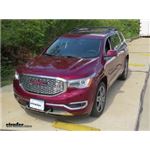

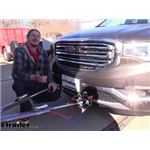


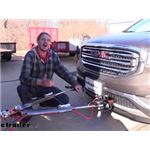
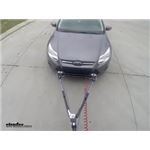

Continue Researching
- Shop: Vehicle Tow Bar Brake System
- Shop: Vehicle Tow Bar Wiring
- Shop: Brake Buddy Stealth Supplemental Braking System - Proportional
- Shop: BrakeBuddy Towed Vehicle Battery Charge Line Kit
- Shop: Base Plate for Tow Bar
- Search Results: curt
- Q&A: Difference Between Blue Ox Patriot II and Patriot BLU37TR Braking System
- Search Results: blue ox braking system
- Shop: Curt Rambler Non-Binding Tow Bar - RV Mount - 2" Hitch - 7,500 lbs
- Shop: Curt Universal Tail Light Wiring Kit for Towed Vehicles
- Shop: Swagman XC2 Bike Rack for 2 bikes - 1-1/4" and 2" Hitches - Frame Mount
- Shop: Curt Custom Base Plate Kit - Removable Arms
- Shop: Replacement All-in-1 Connector Socket for Brake Buddy Stealth Flat Tow Brake System
- Search Results: batteries
- Search Results: brake buddy
- Shop: Trailer Hitch
- Search Results: solar battery charger
- Search Results: trailer hitch ball mount
- Video: Brake Buddy Stealth Supplemental Braking System Installation - 2016 GMC Canyon
- Article: What is an RV-Approved Bike Rack? (And Do You REALLY Need One?)
- Q&A: Availability of Replacement Bolt for Swagman XC2
- Video: Brake Buddy Stealth Supplemental Braking System Review
- Search Results: trailer hitch ball
- Video: Review of Brake Buddy Tow Bar Braking Systems - Brake Systems - HM39530
- Q&A: Will Odometer Advance When Flat Towing a 2019 GMC Acadia Denali?
- Video: Demco Stay-IN-Play DUO Braking System Installation - 2019 GMC Acadia
- Video: Roadmaster 4-Diode Universal Wiring Kit Installation - 2019 GMC Acadia
- Shop: Suspension Enhancement
- Shop: Trailer Wiring
- Article: Brake Controller 7- and 4-Way Installation Kit (ETBC7)



